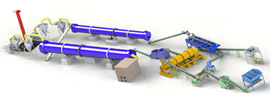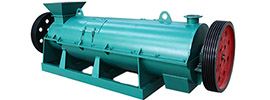I. Policy and Compliance Requirements
1. Environmental Approval
- Environmental Impact Assessment (EIA) Filing: Must pass the EIA review by the local ecological environment bureau and submit an Environmental Impact Report. Key requirements include:
- Air Emission Control: Fermentation exhaust must be treated via a "biological deodorization tower" to meet GB16297-1996 standards.
- Wastewater Management: Domestic sewage must be treated in septic tanks and reused; production wastewater is prohibited from direct discharge.
- Solid Waste Handling: Hazardous waste (e.g., waste lubricants) must be entrusted to licensed disposal units; general solid waste (e.g., dust, packaging) must be classified and collected.
- Site Selection Restrictions:
- The plant must be at least 3 km away from residential areas, schools, water sources, and other sensitive targets.
- Land use must comply with urban planning and be designated as construction land.
2. Production Licenses and Certifications
- Fertilizer Registration Certificate: Required from the provincial agricultural department, with products meeting:
- General Organic Fertilizer: NY/T 525-2021 (organic matter ≥45%, total nutrients ≥5%).
- Bio-Organic Fertilizer: NY 884-2012 (effective viable bacteria count ≥0.2 billion/g).
- Business License: Scope must explicitly include "production and sales of organic fertilizer."
3. Agricultural Subsidy Policies
- National Subsidies:
- Production Subsidies: Subsidies range from 50 to 300 yuan/ton based on output.
- Tax Incentives: VAT exemption; corporate income tax incentives (e.g., "three-year exemption, three-year reduction" for resource utilization projects).
- Equipment Subsidies: New equipment under 5 million yuan qualifies for one-time pre-tax deduction.
- Local Subsidies:
- Scale-Based Rewards: Plants producing over 30,000 tons/year in Jiangsu receive a 1 million yuan subsidy.
- Equipment Purchase Subsidies: 30–50% subsidies for livestock manure treatment equipment in Sichuan.
II. Site and Equipment Requirements
1. Site Planning
- Land Area: 10–15 mu required for a 10,000-ton/year plant. Layout includes:
- Fermentation Area: Trench or tank fermentation workshops (recommended: intelligent molecular membrane fermentation systems).
- Production Area: Crushing, mixing, sieving, and packaging equipment.
- Storage Area: Raw material yards and finished product warehouses (moisture-proof and ventilated).
- Infrastructure:
- Rainwater-sewage diversion systems and initial rainwater sedimentation tanks.
- Hazardous waste storage rooms compliant with GB18597-2023.
2. Equipment List
| Equipment Type |
Function |
| Fermentation System |
Trench/tank fermentation |
| Crusher |
Raw material crushing |
| Mixer |
Mixing raw materials with agents |
| Sieve |
Separating uncomposted materials |
| Packaging Machine |
Automatic weighing and packaging |
| Environmental Equipment |
Deodorization towers, dust collectors |
III. Raw Materials and Technical Standards
1. Raw Material Sourcing and Quality Control
- Primary Materials: Livestock manure (antibiotic-free), crop straws, fungal residues, and kitchen waste.
- Supply Agreements: Long-term partnerships with breeding farms to ensure stable supply (recommended: 3-month reserve).
- Prohibited Materials: Industrial waste with excessive heavy metals or domestic garbage.
2. Production Process
- Pretreatment: Crush raw materials to ≤5 cm粒径, adjust moisture to 50–60%.
- Fermentation:
- Aerobic Fermentation: Maintain temperature at 55–70°C for 7–15 days, with regular turning.
- Maturity Standards: Ascaris egg mortality ≥95%, fecal coliform count ≤100/g.
- Post-Treatment: Ageing for 7 days, sieving uncomposted materials, and adding functional bacteria (e.g., phosphate-solubilizing bacteria).
- Testing: Each batch must undergo organic matter, nutrient, and heavy metal testing, with samples retained.
3. Quality Control System
- Laboratory Setup: Equipped with organic fertilizer analyzers, moisture meters, and pH meters.
- Third-Party Testing: Regular submissions to CMA-certified institutions for compliance reports.
IV. Funding and Market Strategies
1. Investment Budget
- Small Plant (5,000 tons/year): Equipment (80–150万) + site construction (30–50万).
- Medium Plant (10,000–20,000 tons/year): Equipment (200–500万) + site construction (80–120万).
- Working Capital: Reserve 30% of total investment for raw materials and operational costs.
2. Sales Channels and Models
- B2B Clients: Partner with large-scale growers and cooperatives (e.g., vegetable/fruit bases) via long-term contracts.
- Government Projects: Participate in tenders for "fertilizer reduction" and "soil improvement" initiatives.
- E-Commerce: List on platforms like Ali Agri and JD Agri to promote specialized products (e.g., tea-specific fertilizer).
- Branding: Apply for "China Organic Product Certification" and "Green Food Production Material Certification."
3. Risk Mitigation Strategies
- Raw Material Fluctuations: Sign保底supply agreements with 3–5 breeding farms.
- Competition Pressure: Develop high-value products (e.g., bio-organic fertilizer with microbial agents).
- Policy Dependency: Apply for "Livestock Manure Resource Utilization" projects to secure central财政support.
V. Plant Construction Process Summary
- Preparation: Market research → site selection → EIA and business license approval.
- Equipment Procurement: Select fermentation systems and environmental equipment based on scale.
- Site Construction: Zoning (fermentation, production, storage).
- Pilot Production: Equipment debugging → small-batch production → quality testing.
- Subsidy Application: Submit EIA reports, production records, and sales vouchers to agricultural authorities.
- Full Operation: Expand sales channels → engage in government projects → maintain quality control.
This structured approach ensures compliance, efficiency, and sustainability in establishing an organic fertilizer plant.
 Send us a Email
Send us a Email Wulong Industrial Cluster
Wulong Industrial Cluster Have any question?
Have any question?



















